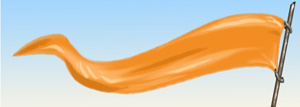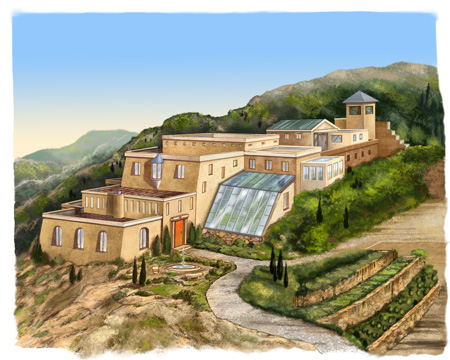The House that Enlil Built, Part 1
by Anthimia Kaltagiron
Anthimia month, AC 228

Last month, "Theophore House," in Acragas, was demolished. It wasn't just torn down, but the entire landscape where it had existed was re-made, with a radical combination of nouergic and conventional deconstruction techniques. Some onlookers, who know the history of the site, commented that the destruction almost seemed like an act of anger or revenge, rather than just a removal for new building on the site. When it comes to Enlil and his legacy, anything is possible. It was often said about Enlil that wherever he went, he brought with him chaos and upheaval. "Theophore House" was no exception.
Enlil's arrival in Acragas, in 172, was not a planned move. It was the result of what might be politely called "career confusion." He had been an adjunct professor at the famous Historikon in Eridu, but had been released due to several reasons, one of which was the unease of the other faculty at the presence of a working Nouergist, endowed with mysterious and disruptive powers. Enlil had not been able to find further academic work, and this was made even more difficult when Enlil participated in the production of a low-budget action film, something he had (in typical Enlil fashion) just happened upon while avoiding the lectures at a conference on the Rhakoteh coast. Shortly after that, he was recruited to teach history and nouetics at a small new institution being founded in the town of Acragas, and there he went.
In the early seventies of the previous century, Acragas wasn't the rich resort town it is now. It was a Keilian fishing village which had become home to a community of rejects, misfits, oddities, and people with what could politely be called "pasts." There were rumors that the unofficial leader of the community, an Eridanian Algon named Tashi who ran the bar and restaurant on the main square, had shot a man dead in a sex and spy scandal and fled Eridu for the rugged North. There were cultists, alcoholic artists, eccentric scientists with unproven theories, and visionaries of various sorts. It was a place where Enlil would fit right in.
The southwest coast of our Trinacria was in those days still almost entirely undeveloped. Keilian fishermen, loggers, and trappers had some settlements there, and wandered through the forests and rocky slopes, but there were no immigrant residences, and none of the ultra-expensive vacation estates and resorts which now populate the "Coast of Warmth," as the advertisers have named it. It was easy for Enlil, with some backing from his friends and his financially successful sister Ninlil, to acquire a fairly large number of hectares of coastal land for building what Enlil hoped would eventually become a "Theophoric Institute."
He recruited his own mentor, the Nouergic architect Apsou-Ari, to help him with the project design. She was well-connected in Trinacria, having built the "Crystal City" towers in Surakosai in the previous decade. Even though Apsou was then the head of state in Eridu, she managed to contribute architectural designs and even made a couple of brief visits to supervise the construction, which broke ground in 173.
By the next year, though, Apsou was off the project, not only because of obvious time constraints, but because her presence had brought unwanted attention to Acragas (which hosted not just Tashi, but many exiles and rejects from Eridu). And even more, Enlil wanted to continue the design work himself, even though he was not trained as an architect. Architectural historians who reverently chronicle Apsou-ari's work refuse to consider "Theophore House" authentic Apsou, because of Enlil's re-designs. According to the Khemaru, Mereth Kahn, currently the only Nouergist working as an architect, Enlil's modifications returned the house to the blocky, squarish and somewhat crude lines of Keilian vernacular, rather than the more graceful forms that Apsou had envisioned.
The house was finished in 175, and named "Windhaven," a name which quickly devolved simply to "Theophore House." But as soon as Enlil occupied it, he was called to Surakosai to serve as the Eridanian consul. Throughout the next forty years, Enlil would be only a part-time occupant, commuting back and forth to Acragas from wherever he was stationed. He would teach, on an irregular schedule, at the University of Surakosai as well as doing guest semesters elsewhere. As the years went on, he and his students and assistants built additions onto the house. The seaside sprawl included a courtyard, a laboratory for biological and nouergic investigations, a glassed-in winter garden, and even, at one point, a chicken coop. His more agriculturally minded students built terraces for vegetable gardens, and the athletically inclined built a stamat game court which also served as a landing platform for small liftcraft.
Theophore House at its best, around 200 A.C.

For a larger version of this image, go here.
Over the years, there wasn't anyone in the nouergic community, it seems, who didn't visit Theophore House one time or another. Enlil had guest cottages built lower on the property, to accommodate sensitive types who needed a nouetically isolated environment. At any time, whether Enlil was there or not, someone or a group of someones populated the house. An informal group of his students and a few of his Lord of Memory relatives kept the place active and hospitable. When the master was there, he indicated his presence by flying an orange banner from a metal pole fixed on the topmost roof level.
TO BE CONTINUED
Posted at 12:02 am | link
Archives:
October 2011 (1)
September 2011 (1)
September 2010 (1)
July 2010 (2)
June 2010 (1)
May 2010 (2)
April 2010 (14)
March 2010 (3)
June 2009 (1)
May 2009 (1)
April 2009 (3)
March 2009 (2)
February 2009 (4)
January 2009 (4)
August 2008 (1)
April 2008 (2)
March 2008 (2)
February 2008 (4)